Plan checklist
The McKinnon Property
1-1059 Crosswinds Cove Rd East, Lake Of Bays
Planting plan created by The District Municipality of Muskoka
Schedule A:
Plants & Property
Land Characteristics
This planting plan is designed based on the land characteristics identified during the day of the site visit. Plants are chosen according to the soil and light conditions on your property. The number of plants chosen for each planting compartment takes into account the square metre area of the space, as well as the amount of current vegetation cover. Your property is part of ecoZone: 5b
Land Characteristics by Compartment
| Length | Width | Area | pH | Soil | Moisture | Light | Height | |
|---|---|---|---|---|---|---|---|---|
| A | 12.4m | 2.7m | 33.5m2 | acidic | sandy, loamy | normal | partial sun | |
| B | 6.2m | 3.5m | 10.8m2 | acidic | sandy, loamy | normal | shade | |
| C | 6.9m | 4.7m | 32.4m2 | acidic | sandy, loamy | normal | partial sun | |
| D | 5.9m | 14m | 82.6m2 | acidic | loamy | normal | partial sun, shade | |
| E | 6m | 4.5m | 27m2 | acidic | loamy | normal | full sun, partial sun | |
| F | 10.3m | 2m | 20.6m2 | acidic | loamy | normal | full sun, partial sun | |
| G | 8.1m | 2.5m | 20.2m2 | acidic | loamy | normal | full sun, partial sun | |
| 55.8m | 4.84m | 227.1m2 |
Plant Selection Summary
The following shrubs and trees are chosen for their suitability and survivability given the current soil and light conditions in each compartment on your property, as well as preferable features.
| Plant Species | A | B | C | D | E | F | G | Potted | Bareroot | Wildflower |
|---|---|---|---|---|---|---|---|---|---|---|
| Bush Honeysuckle | 11 | 3 | 4 | 2 | 20 | |||||
| Alternate-Leaved Dogwood | 1 | 1 | 2 | |||||||
| Smooth Wild Rose | 4 | 4 | ||||||||
| Witch Hazel | 1 | 1 | ||||||||
| Ostrich Fern | 6 | 3 | 6 | 15 | ||||||
| Red Osier Dogwood | 4 | 5 | 1 | 2 | 12 | |||||
| Narrow Leaved Meadowsweet | 6 | 3 | 6 | 3 | 18 | |||||
| Christmas Fern | 3 | 3 | ||||||||
| Ninebark | 2 | 2 | 4 | |||||||
| Beaked Hazel | 1 | 1 | ||||||||
| Red Maple | 1 | 1 | ||||||||
| Bunchberry | 3 | 3 | ||||||||
| Gray Dogwood | 1 | 1 | ||||||||
| Fragrant Sumac | 6 | 6 | ||||||||
| Showy Mountain-Ash | 1 | 1 | ||||||||
| Wintergreen | 5 | 5 | ||||||||
| Canadian Serviceberry | 1 | 1 | ||||||||
| Kalm St. Johns Wort | 3 | 3 | ||||||||
| Yellow Birch | 1 | 1 | ||||||||
| Buttonbush | 1 | 1 | ||||||||
| Sweet Gale | 1 | 1 | ||||||||
| Pussy Willow | 1 | 1 | ||||||||
| Oswego Tea (Red Bergamot) | 3 | 3 | 6 | |||||||
| New England Aster | 3 | 3 | ||||||||
| Purple Coneflower | 3 | 3 | 6 | |||||||
| Sweet Oxeye | 3 | 3 | ||||||||
| Wild Bergamot | 3 | 3 | 6 | |||||||
| Blue Vervain | 3 | 3 | ||||||||
| Black-Eyed Susan | 6 | 3 | 9 | |||||||
| Shining Willow | 1 | 1 | ||||||||
| Subtotal | 16 | 20 | 22 | 16 | 14 | 33 | 21 | 98 | 0 | 44 |
| Totals | 142 | |||||||||
Plant Information
The following table summarizes key information about each plant selected for your property.
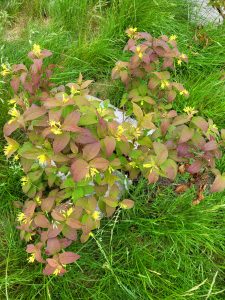
|
Bush HoneysuckleHeight: 1m
The Bush Honeysuckle is a small, hardy, deciduous shrub that rarely grows taller than 1 m in height. The leaves are simple, oppositely arranged, ovate shaped, and have finely toothed margins. During the spring and summer, the leaves are dark green in colour, then in the fall they take on a variety of colours ranging from a deep purple to light yellow. The flowers are small, showy, yellow to orange colored, trumpet shaped, appear in clusters on the tips of branches, and bloom between June and July. The flowers are beneficial to pollinator species, including hummingbirds and butterflies. The roots of the Bush Honeysuckle are fibrous, giving it the ability to form thickets and making it an ideal shrub to plant for erosion control.
|
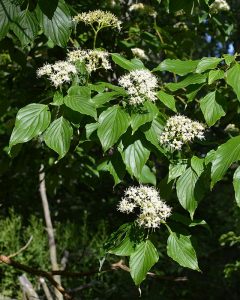
|
Alternate-Leaved DogwoodHeight: 5-10 m
The Alternate-Leaved Dogwood is a tall, deciduous shrub or small tree species that can grow 5-10 m in height. This plant may also be known by the common name Pagoda Dogwood. It can be grown either in the form of a single stem tree or multi-stemmed shrub comprised of two or three smaller trunks. The leaves are ovate shaped, alternately arranged, have prominent veins, have a pointed tip, and have entire margins. The flowers are showy, fragrant, whitish yellow, appear in flat clusters, and bloom between May and June. These flowers produce clusters of dark blue berries. The flowers are beneficial for pollinator species while the berries are beneficial for wildlife species. The root system is valuable for controlling erosion and stabilizing loose soil. This plant is often used as a small ornamental tree in landscaping. The common name comes from the fact that all other Dogwood species have oppositely arranged leaves.
|
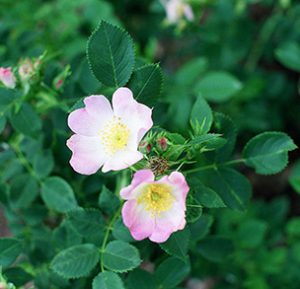
|
Smooth Wild RoseHeight: 1.5m
The Smooth Wild Rose is a shrub species that grows about 1.5 m tall. The name is derived from the fact that it is almost thornless with only a few sharp thorns present near its base. This native shrub is best known for producing beautiful pale pink flowers with five saucer-like petals surrounding a yellow center. The Smooth Wild Rose produces bright red rose hip fruiting bodies which develop during the summer and persist throughout the winter. Leaves produced are alternate and compound, consisting of 5-7 serrated, egg-shaped leaflets.
|
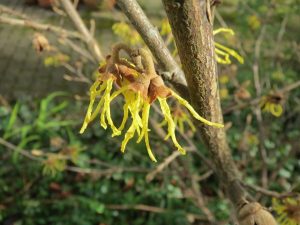
|
Witch HazelHeight: 4-9m
The Witch Hazel is a deciduous understory shrub, with a broad and rounded crown which typically grows 5-9m. This species can sometimes take on the form of a tree. Witch Hazel is most recognizable for its 2 cm long, spidery, bright yellow flowers, which bloom during late fall. Leaves produced are alternate, simple, 6-15 cm in length, and obovately shaped. These leaves are dark green on top with paler undersides and turn yellow during the autumn. Witch Hazel leaves produce hairs on their principal veins, are asymmetrical at their base, scalloped, and sometimes coarsely toothed. In addition, the leaves contain 5-7 straight, parallel, ascending veins per side. The twigs are slender, zigzagged, tawny, and smooth when mature. Witch Hazel fruiting bodies are short, thick, light brown capsules that become woody upon maturation. This species is typically multi-stemmed with two or more trunks, which are crooked and 10-15 cm in diameter.
|
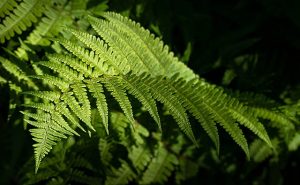
|
Ostrich FernHeight: 1.5 m
The Ostrich Fern is a coarse, erect to arching perennial fern, that can grow up to 1.5 m in height. The stems are clustered and arching while the leaves are ostrich-plume shaped, widest near top, and very gradually narrowed to the base. The size of the leaves grow up to 1.5 m long and 12-40 cm wide, with around 40 pairs of leaflets or pinnae. The leaflets are long, narrow-pointed, and ascending. The leaves are fertile, with spore clusters on the undersides of sub-leaflets.
|
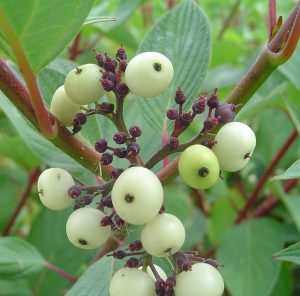
|
Red Osier DogwoodHeight: 1.5-4m
The Red Osier Dogwood is a medium-sized, deciduous shrub native throughout Northern and Western North America which typically grows to 1.5-4m. This species is multi-stemmed with numerous erect and ascending bright red branches that create a loose and spreading form. Leaves produced are simple, two-toned with a dark green upper side and light green underside. They are arranged opposite each other along the branches. During the fall, the foliage turns a brilliant red to dark purple. Clusters of small, creamy white flowers form on the terminal ends of the branches between June and July. The Red Osier Dogwood produces blueish-white fruiting bodies during late summer, which may persist throughout the winter. This shrub's berries provide an important winter food source for numerous species, from large deer to small wintering birds.
|
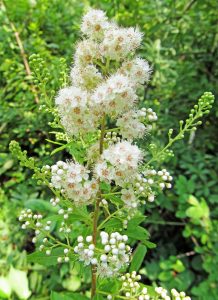
|
Narrow Leaved MeadowsweetHeight: 1-2m
The Narrow Leaved Meadowsweet is an erect, deciduous shrub, which grows in the shape of a mound to a height of 1-2m. This species develops numerous branches and branchlets, giving it a sparse appearance. Leaves produced are simple and narrow with sharply toothed borders growing alternately along the branches. These bright, light green leaves appear crowded, as they grow close together on the stocks and branches. During the fall, leaves turn a yellow-red or yellow-orange colour. Small white to light pink flower clusters appear in the spring growing in a dense, narrow pyramid at the terminal ends of the branches. During late summer to early fall, these flowers produce smooth, papery seed pods.
|
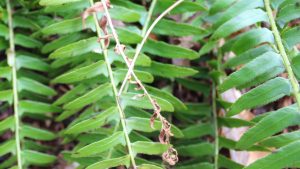
|
Christmas FernHeight: 0.5 m
The Christmas Fern is a hardy evergreen fern which can withstand a variety of environmental conditions. It is one of the most common ferns within North America. This species produces robust, leathery, lace-like leaves which grow in a fountain like clump and persist throughout the winter. Silvery and scaled fiddleheads emerge early in the spring. This fern rarely exceeds heights of half a meter and is a popular fern species to utilize in landscaping due to its year-round colour. This fern is often planted for restoration applications due to its ability to conserve soil and control erosion.
|
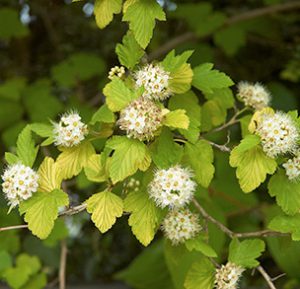
|
NinebarkHeight: 2-3m
The Common Ninebark is a very hardy, large (2-3m in height), deciduous shrub naturally occurring within riparian zones. This species is often planted as an ornamental shrub for its exfoliating bark which reveals reddish-light brown inner bark. This shrub is multi-stemmed with numerous horizontal and ascending branches creating a full, round shape. The Common Ninebark produces dull green, ovate to round shaped leaves with three to five lobes per leaf. During the fall the leaves turn brilliant yellow or dark purple. Between May and June, showy, bell-shaped flowers bloom in clusters on the terminal ends of the branches. During the summer, these flowers give way to small green or green-yellow berries which turn a bright red upon ripening.
|
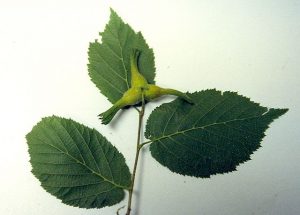
|
Beaked HazelHeight: 4-8m
The Beaked Hazel is a medium-sized (4-8m), deciduous shrub. Beaked Hazel is multi-stemmed with loosely spaced branches. This species produces catkins during the fall and small red flowers during the spring. Pollinated flowers turn to large, round nuts, which ripen mid-fall, and are covered in a bright green husk. These nuts provide a food source for many bird and mammal species including humans. The Beaked Hazel is one of the hardiest of Hazel species and is commonly used for naturalizing and landscaping purposes.
|
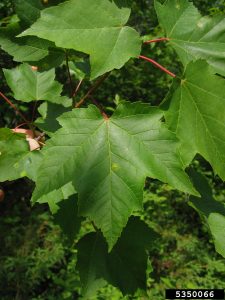
|
Red MapleHeight: 12-25m
The Red Maple is the most common and widespread deciduous tree of Eastern and Central North America. This species can grow 12-25m at maturity. The trunk of this hardwood species is branch free from the base to about halfway up the trunk. When planted in an open area, the trunk can divide and branch out fairly close to the ground. As the tree matures, it develops a short, narrow crown consisting of horizontal and ascending branches. The leaves on the Red Maple grow opposite each other on the branches. During the summer, leaves are bright green on top with a whitish underside. During the fall, the leaves turn a bright red or scarlet colour, from which the name is derived. Prior to leaf development, tree flowers bloom in early May. Red Maple tree flowers are small and red to yellowish orange in colour, growing in clusters on a thin stalk. During June and July, tree flowers develop into reddish winged keys, which hold and disperse seeds. The Red Maple plays an important role in the lumber industry, as its wood is excellent for woodworking.
|
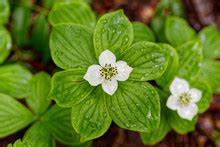
|
BunchberryHeight: 15 cm
Bunchberry is a deciduous ground cover species that can grow around 15 cm in height. This plant may also be known by the common name Creeping-Dogwood. The leaves are deep green, oppositely arranged, oval shaped, and glossy. The flowers are showy, white colored, and bloom between May and June. These flowers produce bright red berries that are edible to humans and beneficial to wildlife species, like birds and small mammals.
|
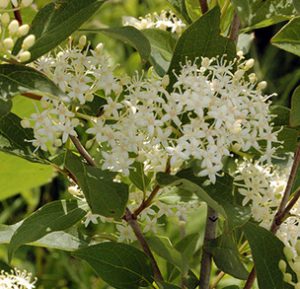
|
Gray DogwoodHeight: 2-3m
The Gray Dogwood, also referred to as Northern Swamp Dogwood or Panicle Dogwood, is a medium-sized, deciduous shrub which typically grows 2-3m. This species is multi-stemmed, with a full, round form. The leaves are green and arranged alternately along the branches. During the fall, leaves turn a bright red to deep purple colour. Between May and June, showy clusters of small white flowers bloom. These flowers turn into white fleshy berries late in the summer. The reddish-pink stems hold the berries throughout the winter, creating an artful contrast to the gray bark and snowy scenery. The Gray Dogwood is tolerant of a variety of environmental conditions and its complex, fibrous root system make it an ideal plant to use for controlling erosion.
|
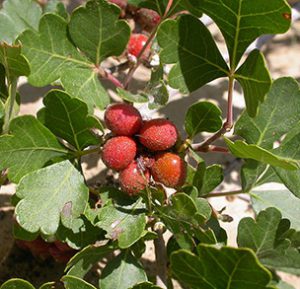
|
Fragrant SumacHeight: 1-2m
The Fragrant Sumac is a medium-sized deciduous shrub within the Cashew family. This species grows between 1-2 meters in height, is multi-stemmed, and produces a round, dense crown composed of erect and spreading branches. Between March and April, small yellow flower clusters bloom on the terminal ends of the branches prior to leaf development. Fruit development begins during late summer. Small, red, hairy berries are produced and can remain on the plant throughout the winter. Male catkins develop on the plant in September. Fragrant Sumac leaves are simple and arranged alternately along the branch. Leaves produced are simple and trifoliate with a large center lobe, appearing similar to Poison Ivy. During the spring and summer, the leaves are light green to green-yellow in colour turning a bright yellow to red or dark purple in autumn. Crushed leaves and stems of the Fragrant Sumac produce a fragrant citrus aroma, hence the common name. The aroma of this shrub is attractive to butterfly species, making it the perfect addition to any butterfly garden. The roots of the Fragrant Sumac are shallow, fibrous, and spread rapidly, making it an ideal choice for stabilizing shorelines and mitigating erosion on steep slopes. Unlike other Sumac species, Fragrant Sumac is significantly less aggressive and easily maintained.
|
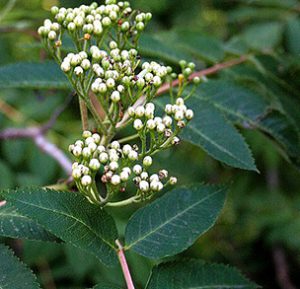
|
Showy Mountain-AshHeight: 15m
The Showy Mountain Ash is a fast growing, deciduous tree which is often planted as an ornamental due to its colourful flowers and berries. This species grows from a straight, narrow, branchless trunk that gives way to a narrow crown, reaching a height of 15m. The bark can be greyish-green or golden-brown and turns scaly with age. As the tree ages, the crown spreads and opens to a more rounded form. Leaves produced are compound with 13-17 leaflets arranged alternately along the branches. Leaves are a vibrant light green and the narrowly elliptical leaflets have tapered tips and fine teeth from tip to middle. During the fall, the foliage turns bright yellow to red. Early in the spring, showy, white flowers bloom in clusters on the terminal ends of branches. They produce large clusters of red berries that remain on the tree throughout the winter. These berries provide an important winter food source for overwintering birds and mammals.
|
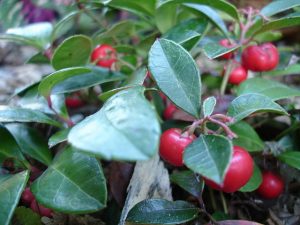
|
WintergreenHeight: 15 cm
Wintergreen is a medium-sized ground cover species that grows up to 15 cm in height. The leaves are glossy, dark-green, simple, oval shaped, and turn purple during the fall. Wintergreen is a visually appealing plant that produces small, white, bell-shaped flowers during the spring. This species yields edible, scarlet red berries during July, which persist throughout the winter months. These berries are a great food source for many song birds, squirrels, deer and a tasty treat for humans when added to pastries or salads. The name Wintergreen comes from the plants ability to keep it's leaves throughout the winter. Wintergreen is unique because their leaves emit a minty aroma when crushed. Wintergreen oil is commonly used in the flavoring of gum and toothpaste.
|
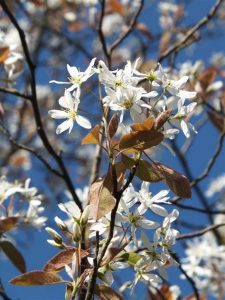
|
Canadian ServiceberryHeight: 3-5 m
The Canadian Serviceberry is a multi-stemmed shrub or small tree which grows from 3-5 m in a dense round form. This plant may also be known by the common names: Juneberry, Shadblow, or Shadbush. Early in the spring, prior to leaf development, clusters of fragrant, showy white flowers bloom along the branches. By July, these flowers give way to the fruiting bodies. The fruits are initially small, green berries, which grow to the size of blueberries and turn a deep purple-blue upon maturation during the fall. Leaves produced are finely toothed and spear-shaped. Throughout the summer, leaves are dark green and turn a dramatic orange-red during the fall.
|
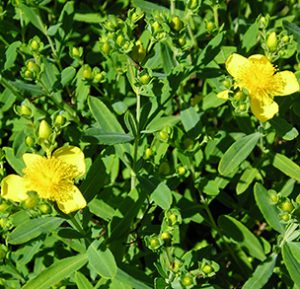
|
Kalm St. Johns WortHeight: 1 m
Kalm St. Johns Wort is a short, evergreen shrub species that typically grows less than 1 m in height. Older bark is reddish brown and appears shedding. The leaves are bluish green colored, narrow and linear shaped, appear in oppositely arranged pairs, and have entire margins. The flowers are showy, golden yellow colored, have five petals, numerous stamens, appear on upper branching stems, and bloom between July and August. These flowers produce small brown oval seed capsules. The flowers are beneficial for pollinator species, like bees and butterflies. These shrubs are visually attractive and used for making low hedges.
|
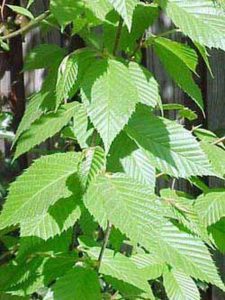
|
Yellow BirchHeight: 25 m
Yellow Birch is a native deciduous tree species that can grow up to 25 m in height. The bark is thin, flaky, shiny, and can be brownish-yellow, bronze, or silvery colored. The leaves are deep greenish-yellow, simple, alternately arranged, oval shaped, have doubly serrated edges, and are about 8-11 cm long. This tree species produces catkins in April-May, which are slim, cylinder shaped, yellowish brown flower clusters. In the Fall, seed pods are produced that are brown colored, cone shaped, and break apart easily. Yellow Birch is a slow growing tree but can live up to 150 years. This tree species is beneficial to wildlife species like birds and mammals.
|
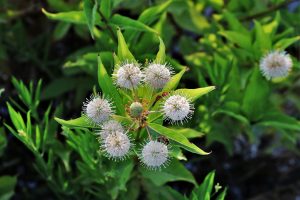
|
ButtonbushHeight: 2 m
Buttonbush is a small to medium-sized deciduous shrub species which typically grows about 2 m in height. This plant may also be known by the common name Button Willow. Twigs are slender to stout and dark red-brown in colour with white speckling. The leaves are bright green coloured, shiny, ovate shaped, oppositely arranged, and have entire margins. The flowers are tiny, tubular, white, fragrant, and appear densely on distinctive, spherical clusters in June. These flowers turn into a dense cluster of seeds, which remain on the plant throughout the winter. The flowers are beneficial for pollinator species, including hummingbirds and butterflies. This is a hardy, adaptable species and an excellent choice for planting on wet shoreline sites.
|
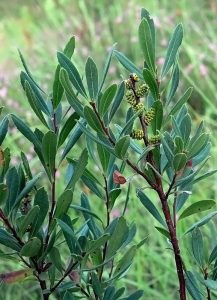
|
Sweet GaleHeight: 1-2m
Sweet Gale is a medium-sized shrub which grows into a thick bush about 1-2 m tall. This species produces 1-8 cm long, oblong-lanceolate leaves which are finely toothed at the tip and are spirally arranged. When bruised, these leaves give off a pleasant aroma. Male and female catkins are produced on separate plants. The seeds are dispersed from the female plants via water, as they float on two corky bracts. This shrub also provides a good food source for bird species that eat the seeds including Grouse, Chickadees, and Bluebirds. Mammal species like Beavers and White-Tailed Deer also browse on the twigs and leaves of this plant.
|
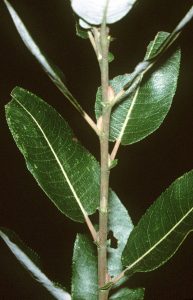
|
Pussy WillowHeight: 6m
The Pussy Willow is a fast growing, deciduous shrub or small tree found reaching heights of 6m, and is from British Columbia to Newfoundland. This species grows from shoots extending from the base of the trunk, creating a multi-stemmed, tall, round bush. The Pussy Willow is an ideal species for bank stabilization and erosion control due to its large, fibrous root system and love of water. This species branches extend from the main shoots and are usually hairy and reddish-brown in colour. The main shoots of Pussy Willow are smooth and greyish-brown, becoming scaly with age. It produces simple, narrow, lance-shaped leaves alternately arranged along the branch. The Pussy Willow yields purple-brown fuzzy catkins which will form long-beaked and finely haired capsules during May and June.
|
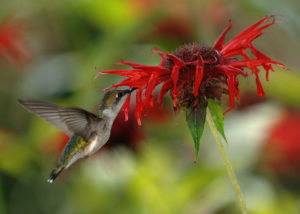
|
Oswego Tea (Red Bergamot)Height: 50 cm
Oswego Tea is a showy perennial wildflower species that typically grows about 50 cm in height. This plant may also be known by the common names Red Bergamot or Scarlet Beebalm. The leaves are dark green, oval shaped, have a minty fragrance. The unique flowers are bright red and grow in dense rounded clusters, with individual tubular flowers that bloom between May and October. The beautiful flowers of Oswego Tea attract various pollinator species like hummingbirds, butterflies, and bees. The Oswego Tea plant is susceptible to a common fungal disease, called powdery mildew, when planted in dry soils. Historically, the leaves of the plant have been used for antiseptic purposes, as well as poultices to heal minor wounds and skin infections.
|
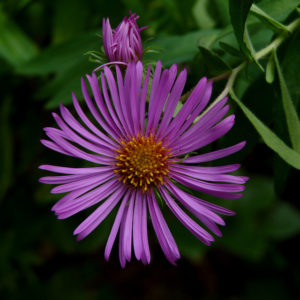
|
New England AsterHeight: 2m
New England Aster is a showy perennial wildflower with an average height of about 120 cm but can grow up to 2 m tall. It has a central stem with branching in the upper half covered in fine white hairs. Its leaves clasp these stems as they have no petioles. The basal leaves are spatula-shaped, while the stem leaves are alternate and lance-shaped. The leaves are also covered in soft white hairs. Its showy flowers are clustered at the ends of the central stem and surrounding branches. Each flower is composed of 30+ deep purple ray florets surrounding numerous golden disk florets. These plants excel in moist soils with lots of sun. It is often found along lake shorelines, forest edges, in wet meadows, or in marshes/swamps. New England Aster reproduces and spreads using both achenes, which are dispersed by wind and a rhizomatous root system, allowing this plant to colonize open areas. It is also known to easily colonize recently disturbed areas so could be considered for difficult sites that are hard to grow on. This wildflower species attracts lots of pollinators such as bees and butterflies but rarely attracts wildlife, such as wild turkey, deer, and rabbit.
|
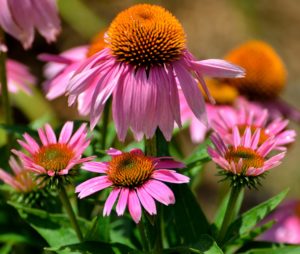
|
Purple ConeflowerHeight: 1m
Purple Coneflower is a perennial wildflower that typically grows about 1 m tall. This plant may also be known by the common name Echinacea. The leaves are dark green coloured, alternately arranged, lance shaped with pointed tips, and have serrated margins. The flowers are showy, pale purple to pink, have 15-20 toothed petals, appear atop erect stems, and bloom between June and August. This wildflower spreads well and can be used to naturalize un-vegetated areas. The roots can be useful for controlling erosion and stabilizing shorelines. This flower blooms for long periods. The flowers are beneficial to pollinator species, like bees and butterflies. The seeds are also beneficial to wildlife species, like birds and small mammals.
|
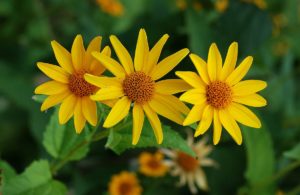
|
Sweet OxeyeHeight: 2m
Sweet Oxeye, also known as False Sunflower, is an attractive, herbaceous, perennial wildflower, which can grow to almost 2 m tall. The flowers are perched atop a stiff stem, with a brownish-yellow center cone surrounded by bright yellow to orange rays. Leaves are 5-12 cm long and 2-8 cm wide, oppositely arranged along the stem, ovate to lanceolate in shape, and have a toothed margin. This wildflower grows best in moist, well-drained soils, preferring full sun, but will tolerate partial shade. Some common natural habitats for the Sweet Oxeye are prairies, meadows, forest edges, and stream banks. Sweet Oxeye is drought tolerant so could be planted in difficult dry sites, but will grow best with regular watering. A large variety of insect species are attracted to the Sweet Oxeye, making it a great addition to a habitat garden.
|
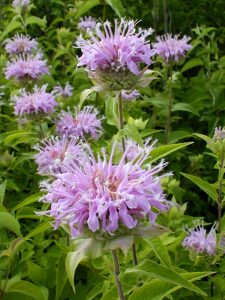
|
Wild BergamotHeight: 1 m
Wild Bergamot is a perennial wildflower species that is member of the mint family and can grow about 1 m tall. Its stems are light green and smooth with abundant branching on the upper half. The leaves are oppositely arranged, broadly lanceolate shaped, 6-10 cm long, and have toothed edges. The also leaves emit a aromatic minty/oregano scent when crushed. The flowers are showy, pink/lavender coloured, appear on the ends of flowering stems, and bloom between July and September. The flowers bloom in the center of the head first, moving outwards creating a wreath. The flowers are beneficial to pollinator species, like bees and butterflies. This wildflower spreads well and can be used to naturalize un-vegetated areas. The roots can be useful for controlling erosion and stabilizing shorelines.
|
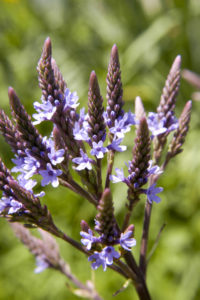
|
Blue VervainHeight: 1.5 m
Blue Vervain is a perennial wildflower species that grows about 1.5 m in height. It has a slender, upright form with reddish-green coloured, rough-haired stems. Its leaves are oppositely arranged, lance-shaped, and on short petioles with large serrations along the edge. Occasionally, there are two lobes present at the base of the leaves. The flowers are showy, blueish purple coloured, have five petals, appear on dense spikes at the top of flowering stems, and bloom between July and September. The flowers bloom first at the bottom of the spike, travelling upwards and blooming in bands. This plant spreads well and can form small colonies. The flowers are beneficial to pollinator species, like bees and butterflies. The seeds are also beneficial to wildlife species, like birds and small mammals.
|
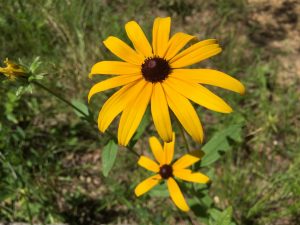
|
Black-Eyed SusanHeight: 1 m
Black-Eyed Susan is a popular biennial or a short-lived perennial wildflower species that typically grows about 1 m in height. Its leaves are green, alternately arranged, lance shaped, and covered with bristly hairs giving the leaf a grey/green colour. The flowers are daisy-like, have 8-20 yellow ray florets surrounding numerous dark brown disk florets, and blooms between June and September. The flowers are beneficial to pollinator species, like bees and butterflies. The seeds are also beneficial to wildlife species, like birds and small mammals. This flower blooms for long periods.
|
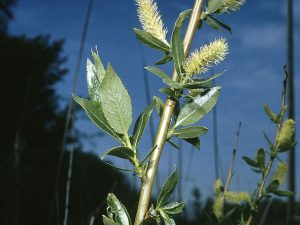
|
Shining WillowHeight: 10m
The Shining Willow is a relatively large deciduous shrub, which grows up to 10 m in height. The shiny leaves are 5-11 cm long and 1-5 cm wide, which are what give this Willow its name. They are lance shaped, with dark green color on the top, and light green on the bottom. Flowers bloom from May to June and range in colour from yellow to a green/brown.
|
Compartment A
Naturalization Area
 pH: acidic
pH: acidic Depth: potted
Depth: potted-
 Moisture: normal
Moisture: normal -
 Soil Type: sandy, loamy
Soil Type: sandy, loamy -
 Light conditions: partial sun
Light conditions: partial sun
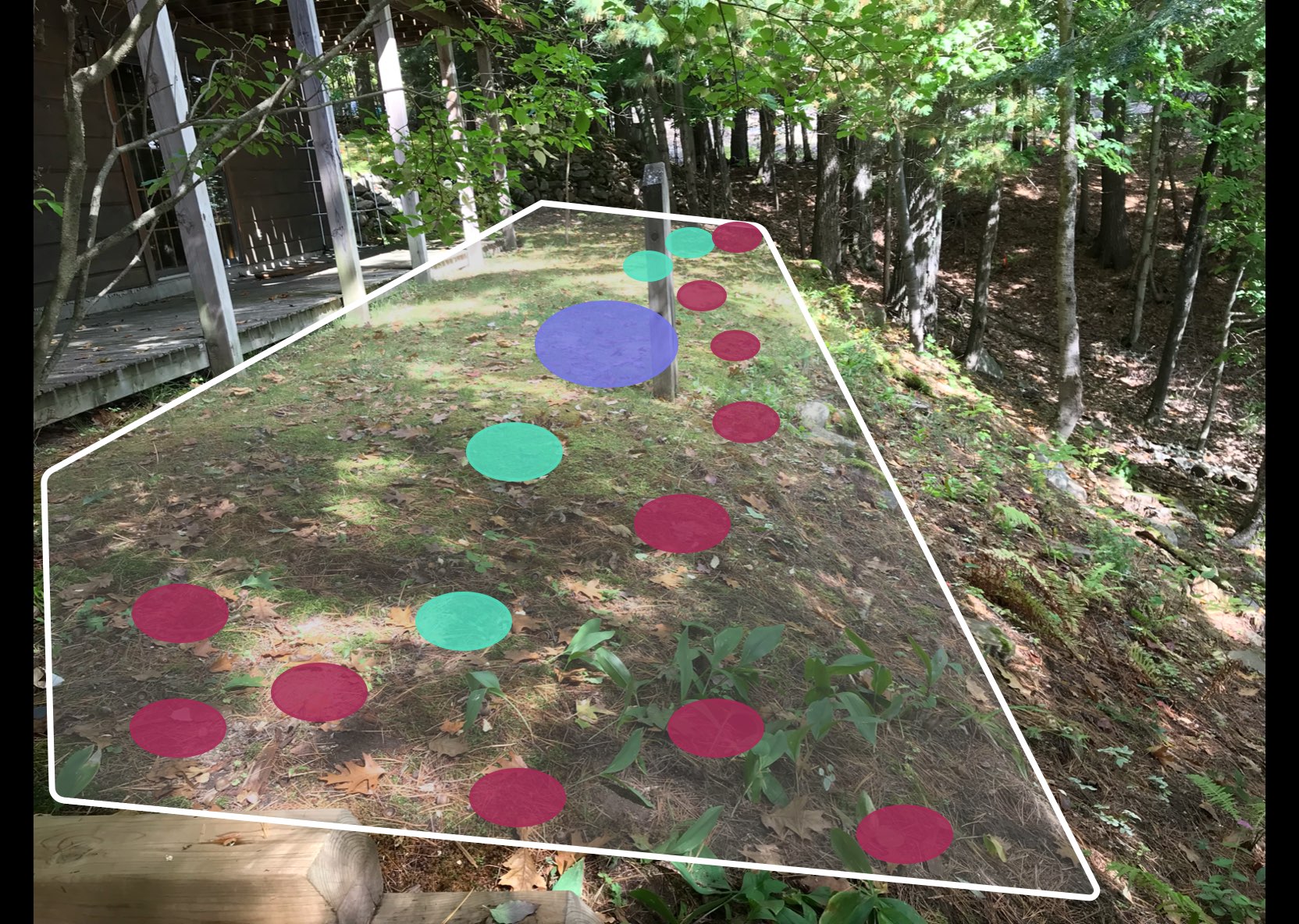
Compartment B
Naturalization Area
 pH: acidic
pH: acidic Depth: potted
Depth: potted-
 Moisture: normal
Moisture: normal -
 Soil Type: sandy, loamy
Soil Type: sandy, loamy -
 Light conditions: shade
Light conditions: shade
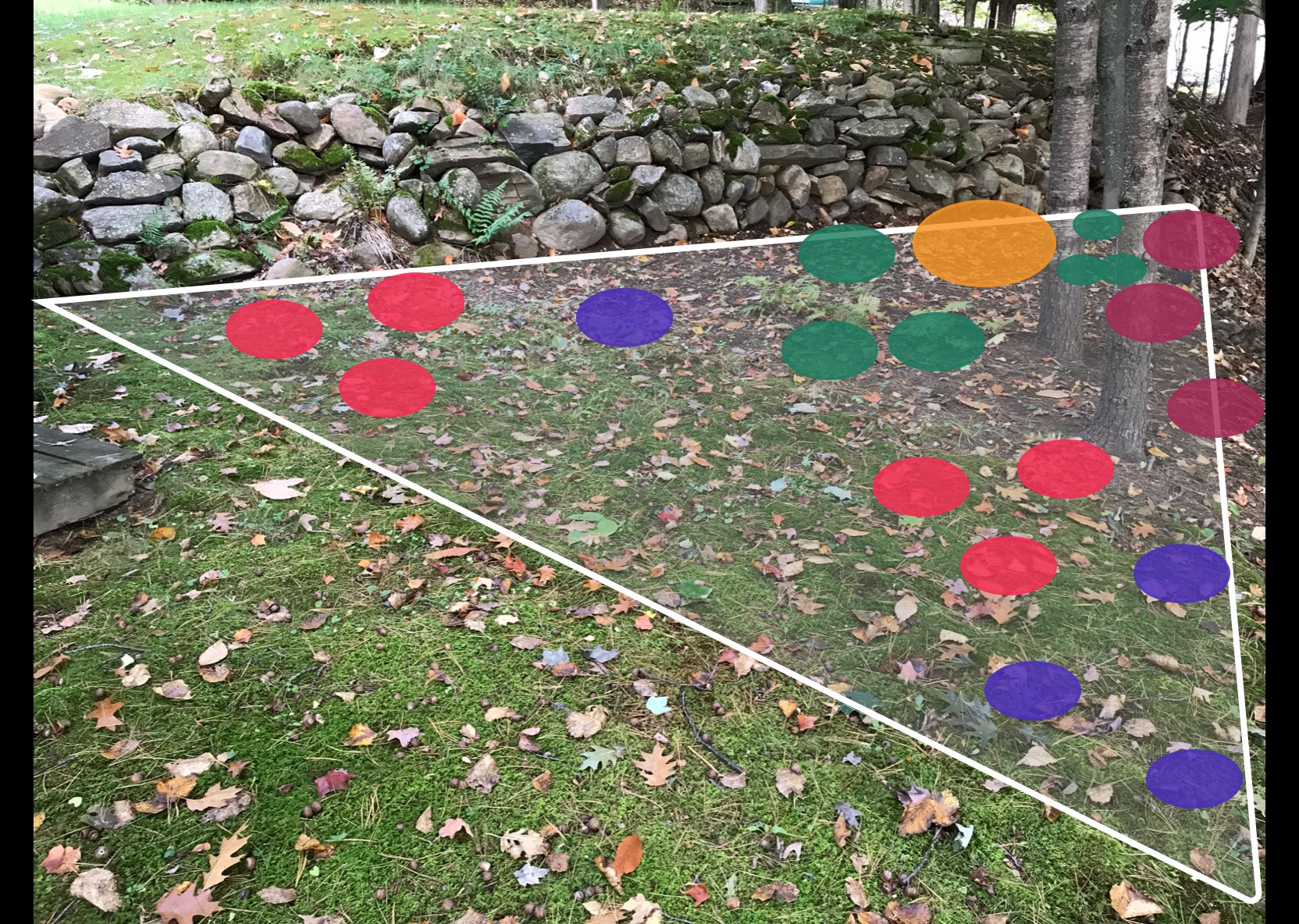
Compartment C
Naturalization Area
 pH: acidic
pH: acidic Depth: potted
Depth: potted-
 Moisture: normal
Moisture: normal -
 Soil Type: sandy, loamy
Soil Type: sandy, loamy -
 Light conditions: partial sun
Light conditions: partial sun
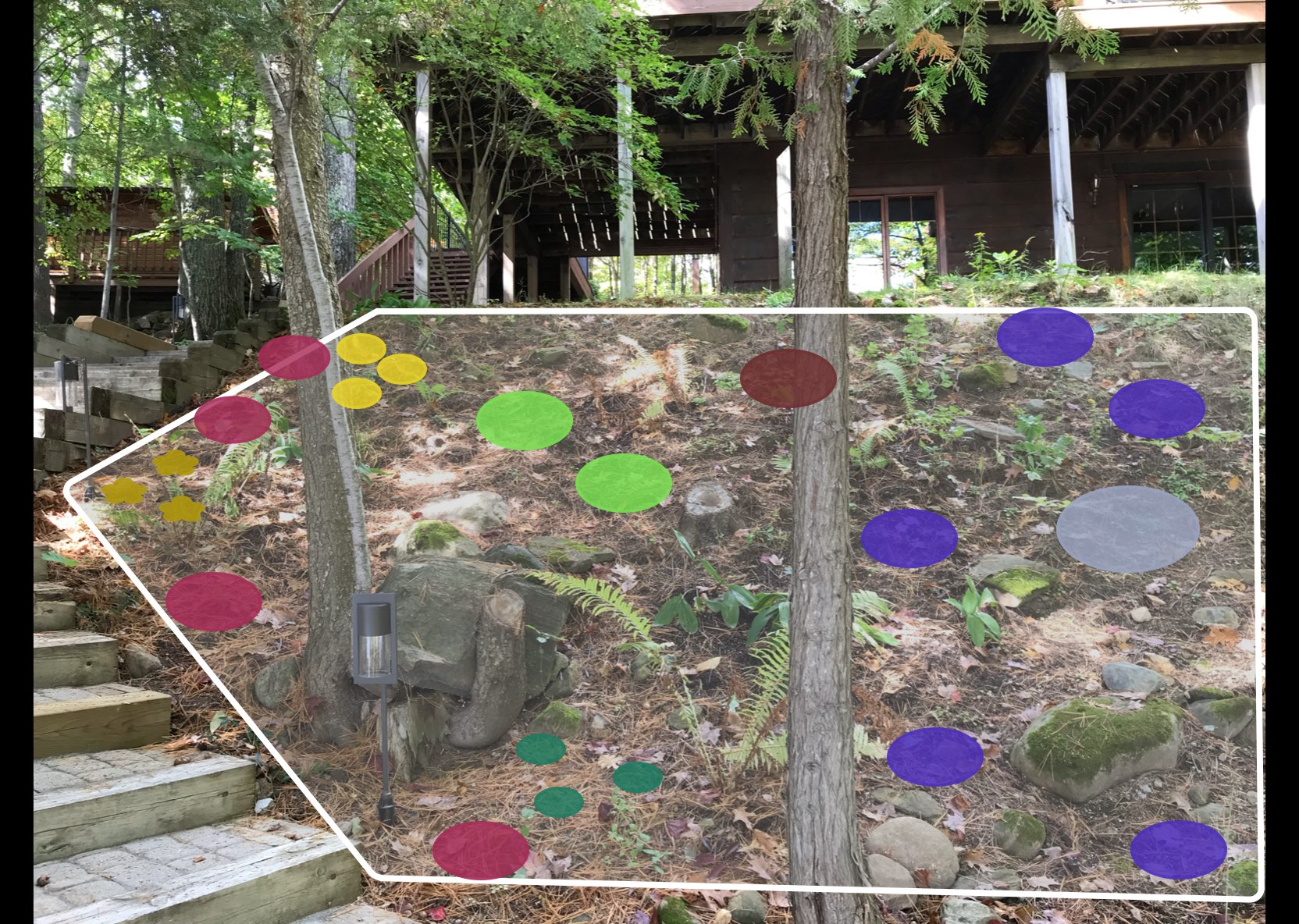
Compartment D
Naturalization Area
 pH: acidic
pH: acidic Depth: potted
Depth: potted-
 Moisture: normal
Moisture: normal -
 Soil Type: loamy
Soil Type: loamy -
 Light conditions: partial sun, shade
Light conditions: partial sun, shade
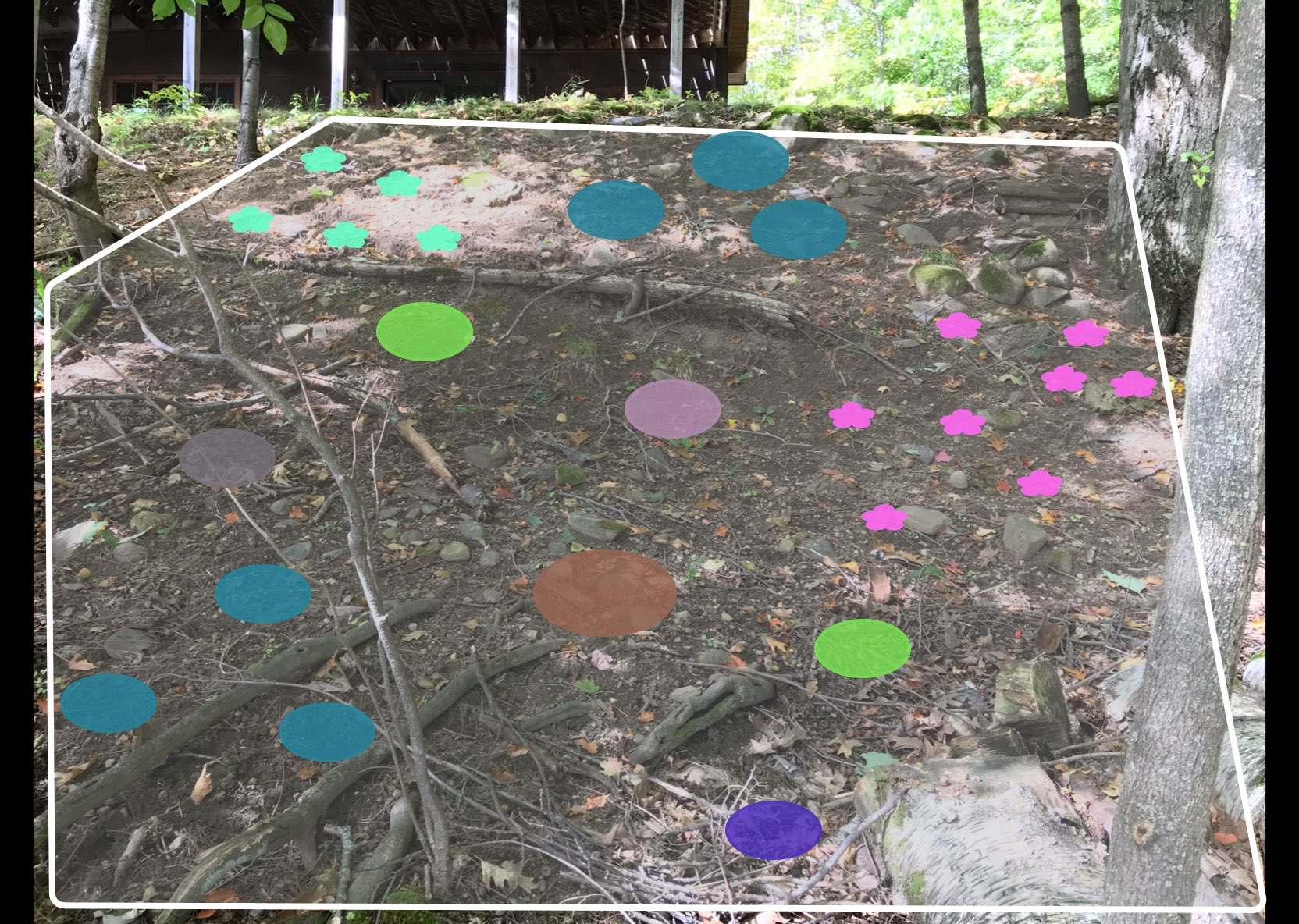
Compartment E
Naturalization Area
 pH: acidic
pH: acidic Depth: potted
Depth: potted-
 Moisture: normal
Moisture: normal -
 Soil Type: loamy
Soil Type: loamy -
 Light conditions: full sun, partial sun
Light conditions: full sun, partial sun
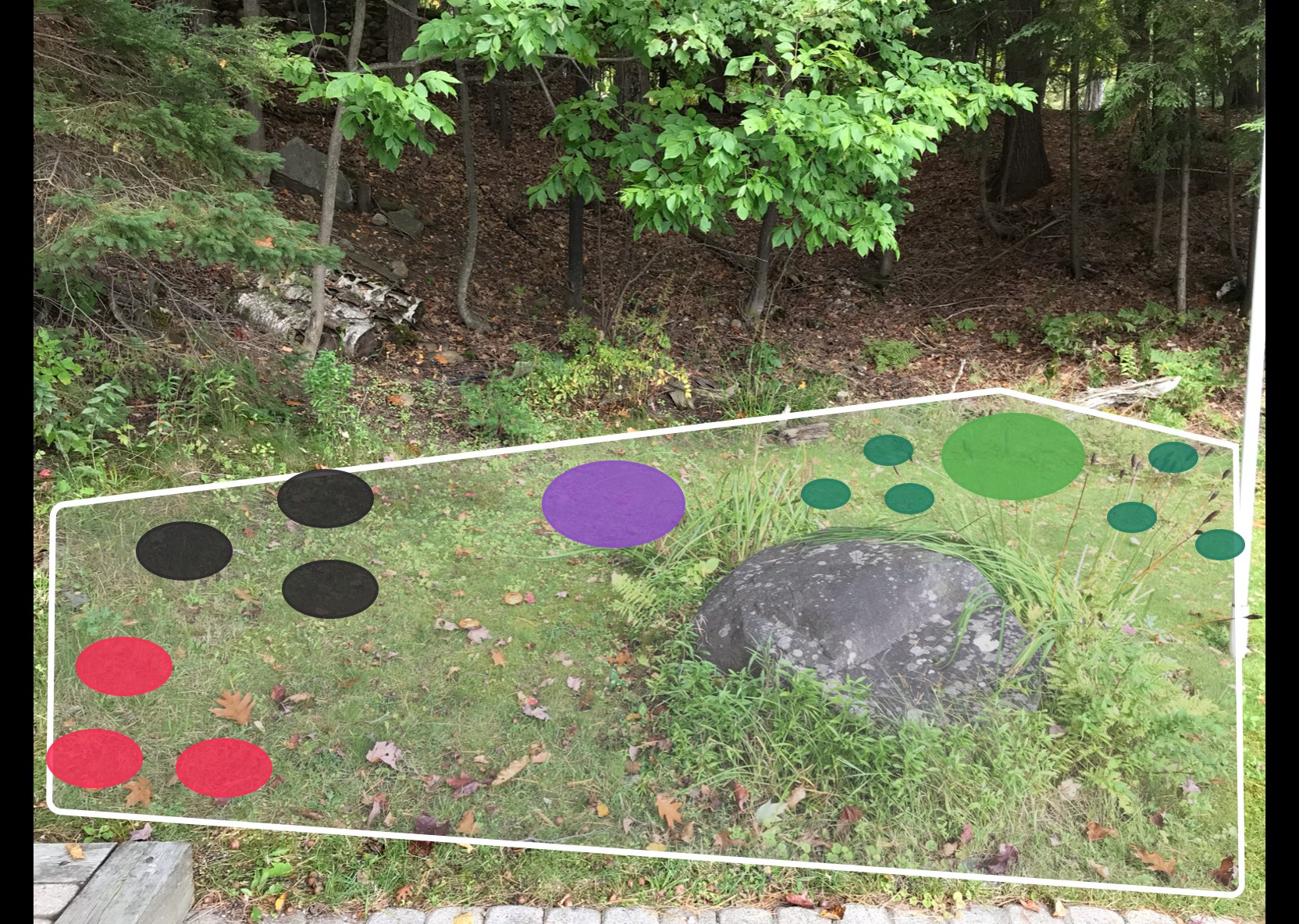
Compartment F
Naturalization Area
 pH: acidic
pH: acidic Depth: potted
Depth: potted-
 Moisture: normal
Moisture: normal -
 Soil Type: loamy
Soil Type: loamy -
 Light conditions: full sun, partial sun
Light conditions: full sun, partial sun
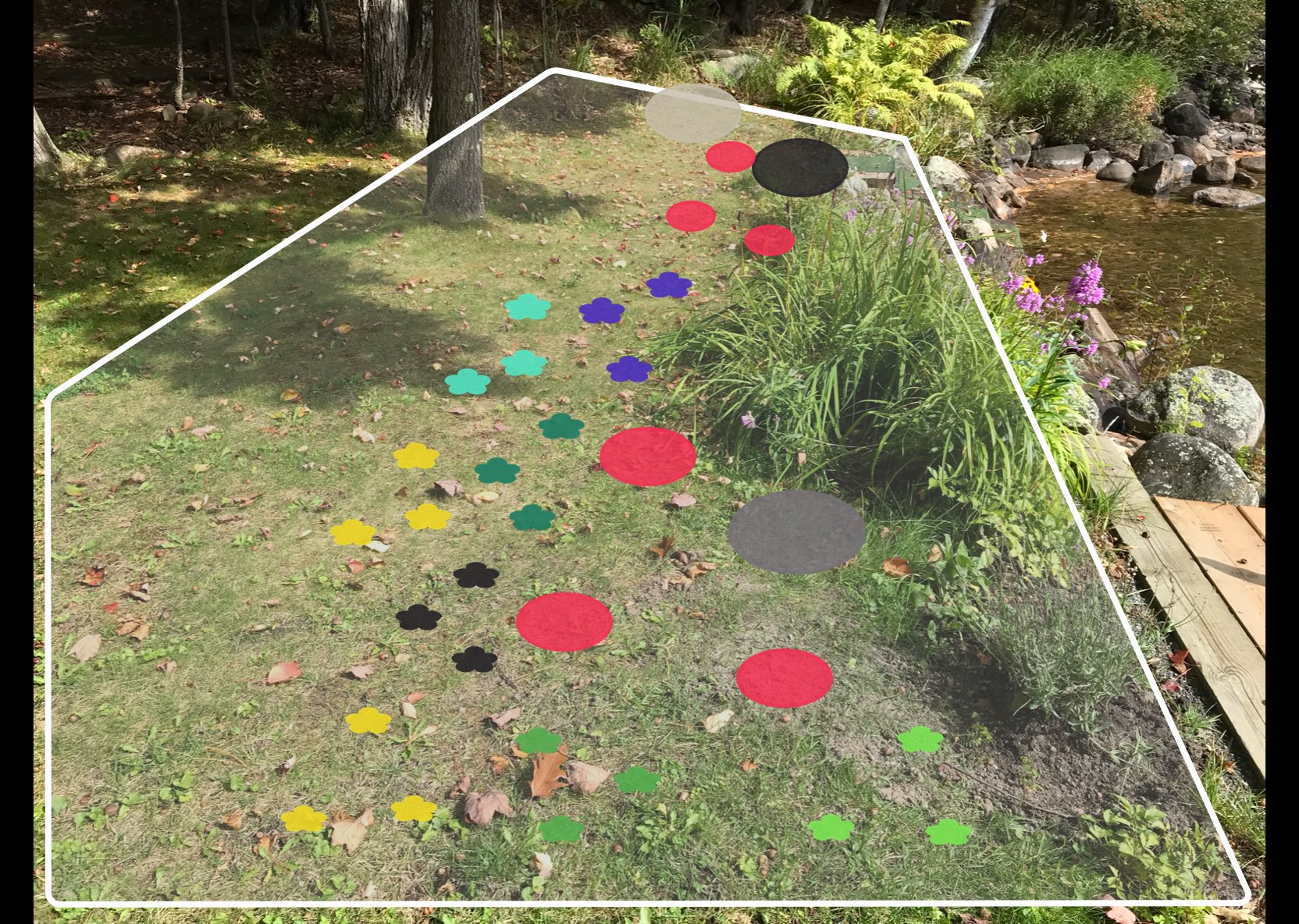
Compartment G
Naturalization Area
 pH: acidic
pH: acidic Depth: potted
Depth: potted-
 Moisture: normal
Moisture: normal -
 Soil Type: loamy
Soil Type: loamy -
 Light conditions: full sun, partial sun
Light conditions: full sun, partial sun
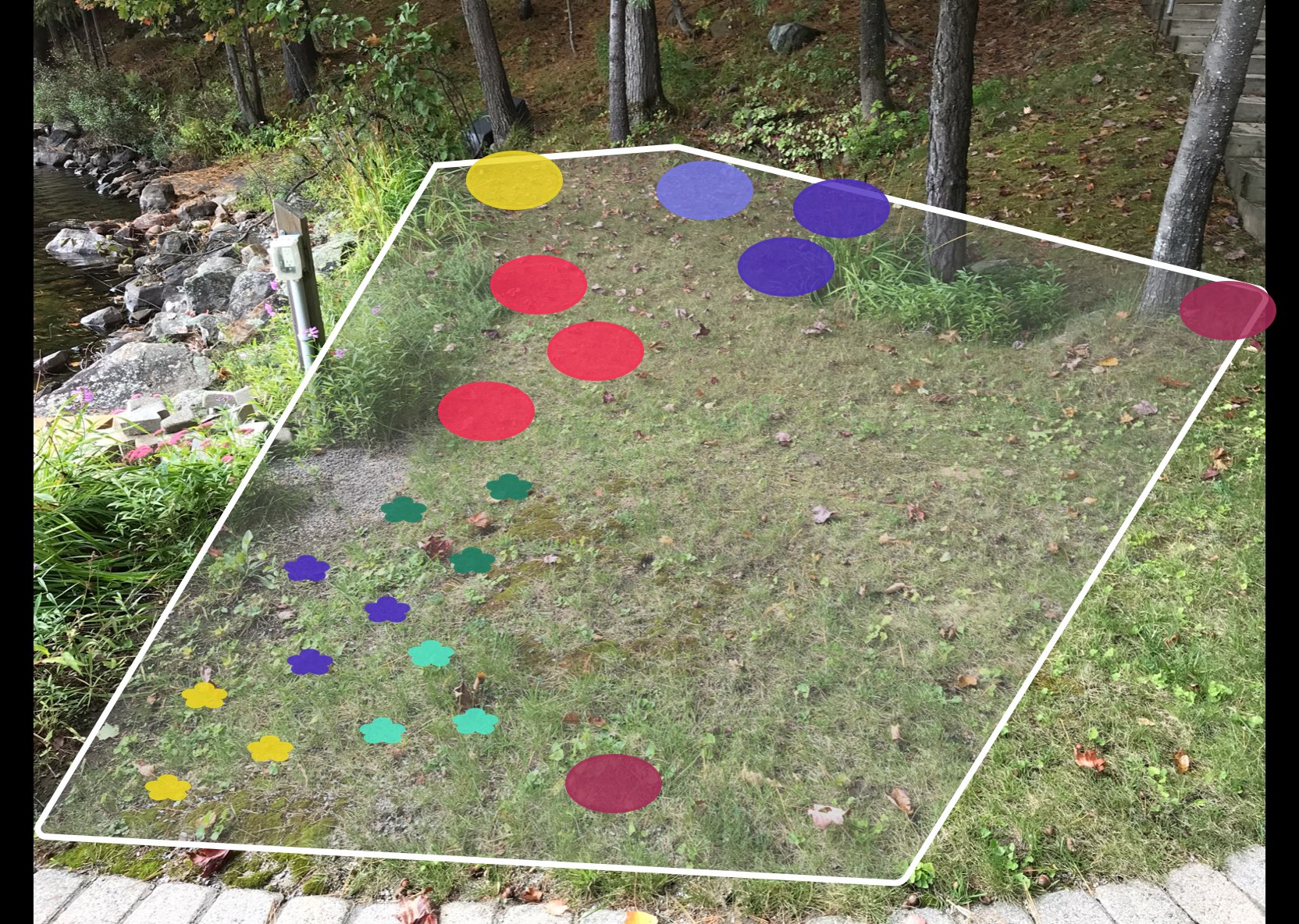
Schedule B
Financial Summary
Project by: The District Municipality of Muskoka
Shoreline Re-Naturalization Starter Kit includes: free site visit, customized re-naturalization planting plan for your shoreline property, native plants including free bare root (small) and potted (large) plants and wildflowers, coconut fibre pads to deter grass from growing around new plantings, tree guards for all deciduous trees, mulch for your wildflowers, Plant Care Guide with instructions on how to take care of your new plants, Habitat Creation Guide and a Wildflower Garden Guide.
Our planting plans are created onsite with you and provide detailed information and plans to re-naturalize your shoreline property. We take photos of areas for planting and overlay native plants that are well suited to your property based on site conditions such as soil type and sunlight availability.
We will work with you to create a plan that works for you including options for low growing plants in areas where views are important.
| Item | Quantity | Cost/Item | Subtotal |
|---|---|---|---|
| Starter Kit fee | $300 | ||
| Free potted plants | 20 | $0 | $0 |
| Paid potted plants | 78 | 12.00 | 936.00 |
| Free bareroot plants | 0 | $0 | $0 |
| Free wildflowers | 30 | $0 | $0 |
| Paid wildflowers | 14 | 6.00 | 84.00 |
| Total costs | 1320.00 |
Schedule C
Project Agreement
Stewardship Agreement
Please indicate your agreement to this proposed plan by signing the following Stewardship Agreement and submitting it, along with your financial contribution, to:
The District Municipality of Muskoka
70 Pine Street
Bracebridge, Ontario
P1L 1N3
Plant Availability
Please note that plant species may need to be changed based on plant stock availability at the time of ordering.
Project Completion
Upon receiving your signed stewardship agreement and financial contribution, a date will be booked for you to pick up your Natural Edge Kit. The District Municipality of Muskoka will supply all plants and materials. If you are paying for the planting to be completed for you, a date will be arranged for The District Municipality of Muskoka to plant your shoreline, bringing the plants and materials with them. If there are particular dates that you would prefer, we will do our best to accommodate your requests.
The Natural Edge Stewardship Agreement with The District Municipality of Muskoka
Agreement made this Day of the Month of in the Year .
BETWEEN Virginia And John McKinnon 1-1059 Crosswinds Cove Rd East Dwight Ontario (Hereinafter called the OWNERS)
AND The District Municipality of Muskoka 70 Pine Street Bracebridge, Ontario P1L 1N3 (Hereinafter called DMM)
WHEREAS the Owners and DMM have met and discussed plans for shoreline naturalization on the specified area(s) in Schedule A existing on the Owners’ land;
WHEREAS the Owners indicate approval of the project as proposed; and
WHEREAS the project is, or will be for the benefit of the Owners and others;
NOW THEREFORE THE PARTIES AGREE AS FOLLOWS:
1. This Agreement shall be in effect for a period of 5 years, commencing with the date of this Agreement.
2. The Owners and DMM agree that the areas where the work is to be performed is as described in Schedule A.
3. The Owners agree to pick up their Natural Edge Starter Kit from DMM’s office and plant their shoreline within two days of receipt. The Owners will provide “after” photos of the work completed to be used for reporting purposes. If the Owners wish to have the planting completed for them, then DMM or it’s contractors, employees and agents will complete the planting at cost, as indicated in Schedule B.
4. If the planting is to be completed by DMM, then the Owners grant DMM, its contractors, employees and agents, the right to enter the property to perform the work agreed upon as outlined in Schedule A. In addition, DMM, its contractors, employees and agents may inspect the work performed for the purposes of monitoring the project and survival assessment, with prior agreement with Owners for date and time of inspection.
5. The Owners agree to contribute the “Landowner contribution” and pay the costs indicated in Schedule B.
6. In instances where the Owners are to pay DMM for work to be performed (outlined in Schedule A), the Owners agree to provide payments to DMM prior to the commencement of that operation. Failure of payment shall constitute a breach of this Agreement and the Owners agree that this Agreement will be terminated and thereupon the Owners agree to pay DMM the estimated costs of the operations of the project completed to date, if any.
7. The Owners agree, if necessary, to perform a reasonable amount of maintenance, which is described in the Native Plant Care Guide, available at naturaledge.watersheds.ca.
8. If a contractor is required to perform the work outlined in Schedule A, then the contractor carrying out the work on the land described will be required to take out and furnish evidence of a comprehensive policy of public liability and property damage coverage. The contractor and their workers will be required to be in good standing with the Workplace Safety and Insurance Board (WSIB) prior to performing the work.
9. The Owners agree not to remove, destroy or alter the project without prior consultation and approval of DMM. Pruning and trimming planted nursery stock, or adding replacement native nursery stock is exempt.
10. The Owners agree not to mow the planted area.
11. The Owners do acknowledge that DMM, its contractors, employees and agents, having performed said works, are not under further obligation with respect to survival of nursery stock, inspection, or maintenance.
12. The Owners, in the absence of negligence, hereby remise, release and forever discharge DMM, its contractors, employees and agents from all claims and demands for injuries, including death, loss, damages and costs in any way related to or connected with installation and maintenance of the work described or resulting from any deleterious effects of the work to the land or to the lands and buildings thereon retained by the Owners.
IN WITNESS WHEREOF the parties have agreed to the contents of this plan; SIGNED:
About this program
About The District Municipality of Muskoka
The District of Muskoka is an upper-tier municipality that has monitored water quality in Muskoka area lakes since 1980. Since 2002, the Muskoka Water Strategy has provided integrated and strategic initiatives for the protection of Muskoka's water resources. The purpose of the strategy is to guide and minimize the impact of human activities on water resources; ensure human and environmental health; and preserve the quality of life in Muskoka.
This program was created by Watersheds Canada
We believe that every person has the right to access clean and healthy lakes and rivers in Canada. At Watersheds Canada, we work to keep these precious places naturally clean and healthy for people and wildlife to continue using for years to come. We love working with others to meet the needs of local communities, whether you’re a concerned citizen, a landowner, a lake association looking for help, or a coalition of groups interested in activating your local community.

